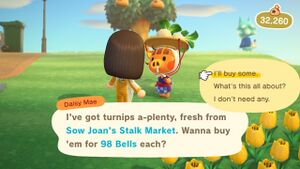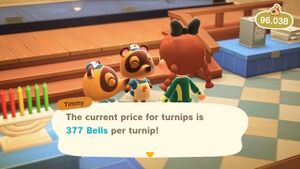Stalk Market
The Stalk Market refers to the system of buying and selling turnips in the Animal Crossing series. In the Stalk Market, players can buy and sell turnips in order to turn a profit, based on its fluctuating value as determined by the town store. The name is a pun on the real-life equivalent known as the stock market.
Buying turnips[edit]
Turnips can be bought from Joan prior to Animal Crossing: New Horizons, or Daisy Mae in New Horizons, during Sunday mornings, before 12 PM. They will sell turnips at some price between 90 to 110 each, but will only sell them in batches of ten. They will only last for a single week, turning into spoiled turnips by the following Sunday which have no value at all. Any turnips at a player's town will spoil if they choose to time travel forwards (outside of their current week) or backwards. In Animal Crossing, the maximum buy price was 120 bells.
In Animal Crossing: Wild World and Animal Crossing: City Folk, the player could only buy a maximum of 990 Turnips at a time. This limit is dropped in subsequent titles, where the player is only limited to how many they can afford and how many slots they have in their pockets.
Turnip prices[edit]
The price of turnips changes per "period" for the entire week. For each day, there are two "periods": morning (before 12 PM) and afternoon (after 12 PM). The player can ask Tom Nook (prior to New Leaf), Reese (in New Leaf), or Timmy and Tommy (in New Horizons) how much they will buy turnips at that particular period. The prices can go from as low as 20 Bells to as high as 660 in a "large spike" pattern. In Animal Crossing, the price could be as high as 990 bells.
The prices also follow a specific pattern. In addition, the pattern for the current week may be influenced partly by last week's pattern.
| Previous week's pattern | This week's pattern | |||
|---|---|---|---|---|
| Large spike | Small spike | Decreasing | Random | |
| Large spike | 5% | 25% | 20% | 50% |
| Small spike | 25% | 15% | 15% | 45% |
| Decreasing | 45% | 25% | 5% | 25% |
| Random | 30% | 35% | 15% | 20% |
Finally, the pattern prices are all relative to the purchase price in the same island. For example 200% purchase price means 180 bells if Daisy Mae was selling them for 90 bells or 220 bells if Daisy Mae was selling them for 110 bells.
Decreasing pattern[edit]
Prices start with 85%-90% purchase price on Monday morning, and will continue to decrease bit by bit after that. The only way to turn a profit is to go on a different town to sell.
Small spike pattern[edit]
Prices usually start with 40%-90% and usually decrease until it gets interrupted (90%-140%). "Usually" because the interruption may occur on the Monday morning or afternoon.
The week's highest price will be three periods after that. For instance, if the interruption was reported on a Tuesday afternoon, the peak will occur on Thursday morning. The peak will always be between 140% and 200% purchase price. Prices will decrease after this peak.
It is possible for the price to decrease a bit in the first or second period following the interruption.
Large spike pattern[edit]
Prices start with 85%-90% purchase price on Monday morning and may continue to decrease exactly like the Decreasing pattern. The spike starts Monday afternoon at the earliest, and Thursday afternoon at the latest. The peak occurs two periods after that (Tuesday afternoon to Friday afternoon). The pattern is characterized by its really large peak which can range between 200% and 600% purchase price. The prices will decrease rapidly after this peak.
Random pattern[edit]
There will be two or three peaks that will never pass 140% purchase price. They can occur at any moment along the week and could easily be confused with all other patterns. It's usually safe to assume early peaks are the Random pattern, but because you're guaranteed at least two peaks, it's usually worth it to wait it out.
Screenshots[edit]
See also[edit]
| Gameplay elements | ||||||||||||||||||||||||||
|---|---|---|---|---|---|---|---|---|---|---|---|---|---|---|---|---|---|---|---|---|---|---|---|---|---|---|
| ||||||||||||||||||||||||||




